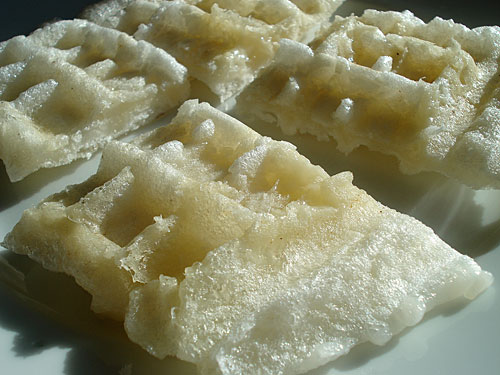
How to make moffles or mochi waffles, a relatively new but very popular snack in Japan, in a regular waffle maker.
Filed under:
japanese snack rice quickcook offbeat gluten-free mochi
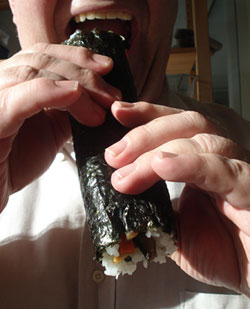 This year, setsubun no hi (節分の日) falls on the 3rd of February (some years it's on the 4th). It marks the start of the spring season or risshun (立春) in Japan according to the old lunar calendar. It's not an official national holiday, but it is celebrated in ways all meant to drive away bad luck and bring in new, good luck. Most of the traditional rituals revolve around beans, because beans are considered to be very lucky. But there is another way of celebrating setsubun no hi, and that's with a big, long, uncut sushi roll called ehou-maki.
This year, setsubun no hi (節分の日) falls on the 3rd of February (some years it's on the 4th). It marks the start of the spring season or risshun (立春) in Japan according to the old lunar calendar. It's not an official national holiday, but it is celebrated in ways all meant to drive away bad luck and bring in new, good luck. Most of the traditional rituals revolve around beans, because beans are considered to be very lucky. But there is another way of celebrating setsubun no hi, and that's with a big, long, uncut sushi roll called ehou-maki.
I grew up in and around the Kanto region, which is the area around Tokyo, so I didn't know about ehou-maki ((恵方巻き)growing up, because it's a Kansai region (the area around Osaka and Kyoto) custom for setsubun no hi. Nowadays though the ehou-maki tradition has become popular nationwide. They are sold everywhere, especially at convenience stores, who take this as an opportunity to get people to celebrate, buy and eat in that awkward gap in between New Year's feasting and Valentine's Day chocolate gorging.
[Edit: ehou is pronounced eh-hoe by the way, not ee-h
aw.]
So, what makes an ehou-maki different from a regular sushi roll? There are basically three rules:
- It must contain seven ingredients, because seven is a lucky number.
- It must not be cut, because it might cut (off) your luck.
- You have to eat it while facing the lucky direction, which changes every year! This year's lucky directly is hinoe (丙 (ひのえ)), which is a little bit to the south of south-south-east on a regular compass. If you can read kanji, this page has a good chart.
- Finally, you must eat the whole roll in total silence.
A seven-ingredient sushi roll is basically a futomaki, or fat sushi roll, and that is what the directions are for. I've suggested several filling variations.
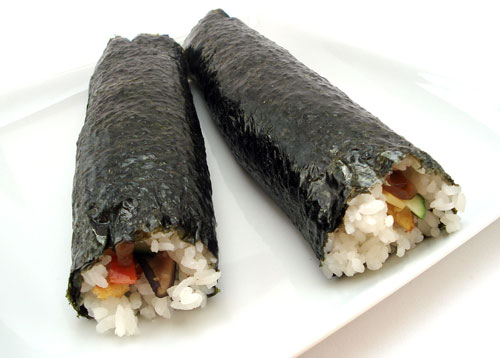
Last year, the Superbowl fell right on Setsubun no hi, so there's a New York-Boston filling combo below. This year, I guess the Cardinals were out of luck, ehou-maki wise. (What would have been a good Pittsburgh-themed sushi roll filling?)
You can of course order a regular futomaki from your favorite sushi takeout, and ask them to put in seven ingredients and to not cut it. Then on Sunday, face the right away, and solemnly eat your roll in total silence.
Filed under:
japanese party food sushi traditions
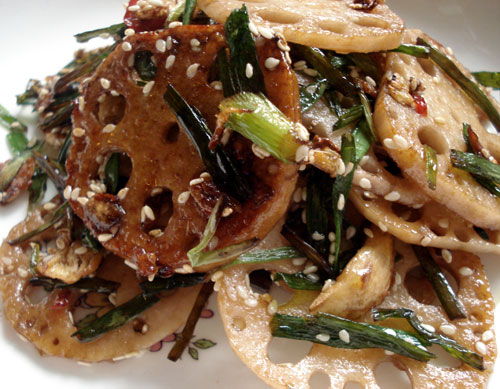
Lotus root (renkon in Japanese) is actually the rhizome of the lotus plant. It's a popular vegetable throughout southern and eastern Asia, but it's still not that well known in the west. Lotus root is full of fiber and various vitamins and other nutrients. In Asia it's believed to have various medicinal qualities, but in macro-nutrient terms it's best to think of it as a starchy vegetable, like potato. Visually of course, it's very appealing with all those little holes. Here I'll explain how it's prepared and eaten in Japan.
Filed under:
basics japanese vegetables vegan
Submitted by maki on 29 January, 2009 - 16:04
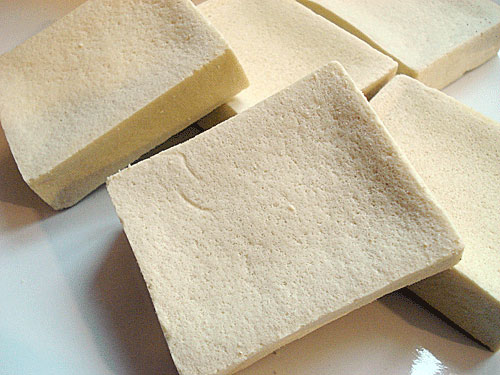
I've talked a little about kohya dofu or kouya dofu (高野豆腐)in the past, but I thought I'd describe it in detail so that I can refer back to it when I use this very versatile Japanese pantry staple in recipes.
Kouya dofu is freeze dried tofu. It's a long lasting pantry staple of most Japanese households.
Type:
feature Filed under:
japanese ingredients vegetarian tofu vegan
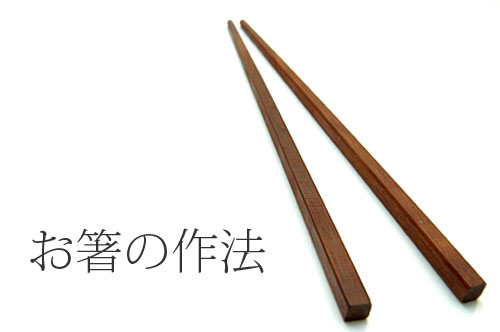
The other day I was having lunch at one of the Asian-fusion restaurants in Zürich with a (non-Asian) friend. At one point, he speared a piece of chicken with one chopstick, brought it to his mouth and pried it off with his teeth. I must have a strange expression on my face, because he looked at me and asked me what was wrong.
Of course he did not know that in Japan, what he just did would be considered to be terribly rude, in the same way that someone who didn't grow up in Europe might not know about not putting your elbows on the table. I explained this to him, and he sort of snorted and said "well why don't you write a guide to chopstick manners on your site then!"
So, here it is: A guide to chopstick etiquette, Japanese style.
Filed under:
equipment japanese offbeat etiquette manners
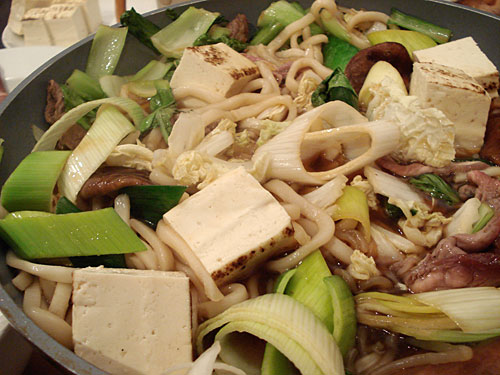
Sukiyaki (すき焼き)is a Japanese word that is widely known outside of Japan, but very few people have actually had the real thing unless they've been invited to a Japanese person's home for dinner - or gone to a traditional inn or ryoutei (high end traditional Japanese restaurant) where it is cooked for you at the table. This is because, like tori nabe, this is really another nabe that is cooked at the table, at home, rather than eaten at a restaurant. You may encounter 'sukiyaki' on some restaurant menus, but if it's been cooked in advance in the kitchen, it really isn't sukiyaki. (I'm not sure why there are dedicated shabu-shabu restaurants but no sukiyaki restaurants, but I think it's because sukiyaki is so strongly associated with home cooking.)
Unlike tori nabe, sukiyaki is not inexpensive, since you need top grade steak-quality meat. If you have access to a Japanese grocery store or a butcher that is familiar with the 'sukiyaki' cut, you can buy ready-cut meat there. (In New York, I used to get sukiyaki meat from Schaller and Weber on the Upper East Side). If you can't get sukiyaki meat, get a piece of sirloin with a good amount of marbling and a thick piece of fat attached. Allow for about 100 grams / 3 1/2 ounces of meat per person. You do not need to use wagyuu or Kobe beef - that would be overkill. In Japan, sukiyaki is the quintessential gochisou (御馳走) - feast or treat, because good beef is the most expensive kind of meat. It's what you have for a special occasion, or just after payday.
Sukiyaki can be enjoyed at any time of the year, but any kind of nabe seems to be best suited to the winter, when the family can gather around the dining table helping themselves from a fragant, steaming pan of food.
There are two basic methods of making sukiyaki: Kanto, or Tokyo-area style, and Kansai, or Kyoto/Osaka area style. Since I'm from the Tokyo area I'll show you how to do the Tokyo style, with a recipe for the Kyoto method below.
Filed under:
japanese party food winter favorites beef washoku nabe

Nabe (鍋, pronounced NA-beh) is the Japanese word for a pot or pan. But it also means a one-pot dish where several ingredients are cooked together in a broth. While nabe can be cooked in the regular way on the stovetop, the most popular kind of nabe are cooked at the table on a portable burner. The quintessential image of a Japanese happy family is one that gathered around the dining table eating a nabe. (Nabe cooked at the table is also called yosenabe (寄せ鍋), which just means a nabe where the ingredients are gathered together (寄せる、yoseru).
Because a nabe is piping hot, it's a great winter meal, with very little preparation.
A lot of Japanese nabe recipes call for ingredients that are only widely available in Japan, but this is a recipe for a nabe that you can recreate wherever you are. It uses chicken and a lot of vegetables, so it's very healthy and frugal - perfect recession cooking! The only special equipment you need is a tabletop cooker of come kind, that can sustain a boiling heat. See more about tabletop cookers in the Notes at bottom.
Filed under:
japanese lighter party food winter quickcook chicken washoku nabe
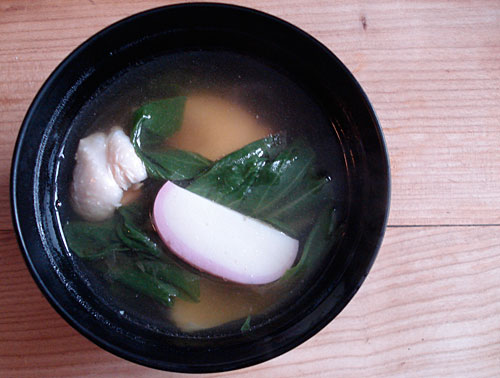
Happy New Year! I wanted to post this a little earlier, but better late than never I hope!
During the New Year holiday period, traditionally rice is not cooked, to give a rest to the cook. Instead, dried mochi cakes were used as the carbohydrate. Ozouni (お雑煮 おぞうに), which literally means 'mixed stew', is a soup with mochi cakes in it. There is no one set recipe, and there are lots of regional variations. This one is a simple Kanto (Tokyo area) style ozouni, the way my mother makes it. It's very simple, not to mention economical - just clear soup, greens, chicken and mochi. Garnish is optional.
Filed under:
japanese chicken new year holidays mochi
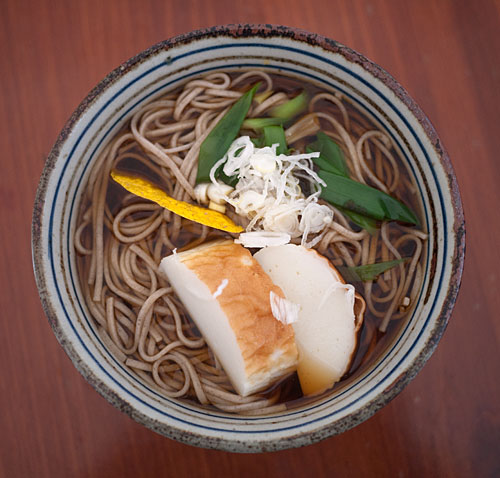
Revised and updated: This recipe for Toshikoshi Soba, or Year-End Soba, traditionally eaten in Japan on New Year's Eve, is one of the earliest recipes posted on Just Hungry. I've expanded the directions so that you can use various methods for making the soup. Originally posted December 30, 2003.
Filed under:
japanese noodles favorites new year soba washoku
Pages